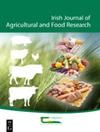Utilising commercial farm grass growth data to evaluate long-term dry matter production of perennial ryegrass varieties
IF 1.4
4区 农林科学
Q3 AGRICULTURE, MULTIDISCIPLINARY
引用次数: 1
Abstract
Little data are currently available on either the dry matter (DM) production of perennial ryegrass (PRG) swards as they age beyond 5 yr (i.e. permanent pasture) or the performance of PRG varieties on commercial grassland farms. Previous work has generally assumed a connection between DM production and ground score (GS) and this link has been used as a proxy for variety persistence. The evolution of technology in the form of PastureBase Ireland has led to agronomic data of individual paddocks being made available for analysis over multiple years which has allowed the long-term assessment of varieties sown as monocultures on commercial farms. This technology allowed for the inclusion of eight PRG varieties sown in 649 paddocks across 101 farms in Ireland in the current analysis. The results show little association between GS and variety DM production as varieties age to 7 yr. Dry matter production of 1- to 4-yr-old swards appeared to provide a strong indication of variety DM production in years 5–7 post-sowing (r = 0.72, P < 0.05). The interaction of variety and sward age was not associated with DM production. Generally, varieties which produced the most DM in younger swards also produced the most DM in permanent pasture swards. Over longer-term periods these variety differences can manifest into large differences in DM produced and consumed on farm. The current analysis suggests that the long-term production benefits of utilising improved PRG varieties in pasture reseeding may be underestimated.利用商业农场牧草生长数据评价多年生黑麦草品种的长期干物质产量
目前关于多年生黑麦草(PRG)的干物质(DM)产量的数据很少,因为它们的年龄超过5年(即永久牧场)或PRG品种在商业草地农场的表现。以前的研究通常假设DM产量与土壤分数(GS)之间存在联系,并且这种联系已被用作品种持久性的代理。通过PastureBase Ireland的技术发展,可以获得多年来单个围场的农艺数据进行分析,从而可以对商业农场的单一栽培品种进行长期评估。在目前的分析中,这项技术允许在爱尔兰101个农场的649个围场中播种8个PRG品种。结果表明,播种后5 ~ 7年,1 ~ 4年龄禾草的干物质产量与品种干物质产量之间的关系不大(r = 0.72, P < 0.05)。品种与苗龄的交互作用与DM产量无关。一般来说,在年轻禾草中产生最多DM的品种在永久草场中也产生最多DM。从长期来看,这些品种差异可能表现为农场生产和消费的DM的巨大差异。目前的分析表明,利用改良的PRG品种进行牧草补播的长期生产效益可能被低估了。
本文章由计算机程序翻译,如有差异,请以英文原文为准。
求助全文
约1分钟内获得全文
求助全文
来源期刊
CiteScore
2.50
自引率
20.00%
发文量
23
审稿时长
>36 weeks
期刊介绍:
The Irish Journal of Agricultural and Food Research is a peer reviewed open access scientific journal published by Teagasc (Agriculture and Food Development Authority, Ireland). Manuscripts on any aspect of research of direct relevance to Irish agriculture and food production, including plant and animal sciences, food science, agri environmental science, soils, engineering, buildings, economics and sociology, will be considered for publication. The work must demonstrate novelty and relevance to the field of research. Papers published or offered for publication elsewhere will not be considered, but the publication of an abstract does not preclude the publication of the full paper in this journal.

 求助内容:
求助内容: 应助结果提醒方式:
应助结果提醒方式:


